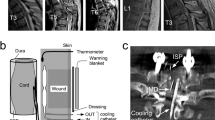Abstract
Hypothermia reduces ischaemic damage to nervous tissue and decreases cerebral oedema. Selective spinal-cord cooling has therefore been proposed as a means of treatment in spinalcord trauma. A miniature heat exchanger, made of Silastic, has been developed that can rapidly induce a central cord temperature of 17°C and may be left in place for several days without complication.
Sommaire
L'hypothermie a pour effet de réduire aussi bien les dégradations occasionnées au tissu nerveux par l'ischémie que l'incidence d'oedèmes cérébraux. Le refoidissement sélectif de la moelle épinière a donc éte proposé comme moyen de traitement dans les cas de trauma du cordon médullaire. Un échangeur de chaleur miniature en ‘Silastic’ a été mis au point qui peut produire rapidement une température de 17°C au niveau du cordon médullaire et qui peut être laissé en place pendant plusieurs jours sans entraîner de complications.
Zusammenfassung
Unterkühlung verringert eine Ischämieschädigung des Nervengewebes und mindert Hirnödeme. Zur Behandlung von Rückenmarksverletzungen wird daher selektive Kühlung vorgeschlagen. Ein aus Silastic bestehender Miniaturwärmeaustauscher ist entwickelt worden, der die Temperatur im Zentrum des Rückenmarks schnell auf 17°C senkt und mehrere Tage ohne Komplikationen im Körper verbleiben kann.
Similar content being viewed by others
References
Albin, M. S., White, R. J., Acosta-Rua, G. andYashon D. (1968) Study of functional recovery produced by delayed localized cooling after spinal cord injury in primates.J. Neurosurg.29, 113–120.
Albin, M. S., White, R. J. andMacCarthy, C. S. (1963) Effects of perfusion cooling of the subarachnoid space.Anaesthesiology24, 72–80.
Albin, M. S., White, R. J., Locke, G. S., Massopust, L. C. Jr. andKretchner, H. E. (1967) Localized spinal cord hypothermia, anaesthetic effects and application to spinal cord injury.Anaesthesia and Analgesia46, 8–16.
Allen, A. R. (1914) Remarks on the histopathological changes in the spinal cord due to impact: An experimental study.J. Nerv. Ment. Dis.41, 141–147.
Bigelow, W. F., Lindsay, W. K. andGreenwood, W. F. (1950) Hypothermia—Its possible role in cardiac surgery: investigation of factors governing survival in dogs at low body temperatures.Ann. Surg.132, 849–866.
Dohrmann, G. J., Wagner, F. C. Jr. andBucy, P. C. (1971) The microvasculature in transitory traumatic paraplegia. An electron microscopic study in the monkey.J. Neurosurg.35, 263–271.
Ducker, T. B. andHamit, H. F. (1969) Experimental treatments of acute spinal cord injury.J. Neurosurg.30, 693–697.
Hansebout, R. R., Lewin, M. G. andPappius, H. M. (1972) Evidence regarding the action of steroids in injured spinal cord. In:Steroids and Brain Edema. Eds.H. J. Reulen andK. Schurmann. Springer-Verlag, New York, 153–155.
Hegnauer, A. H. (1959) Lethal hypothermic temperatures for dog and man.Ann. N.Y. Acad. Sci.80, 315–319.
Kelly, D. L. Jr., Lassiter, K. R. L., Calogero, J. A. andAlexander, E. Jr. (1970) Effects of local hypothermia and tissue oxygen studies in experimental paraplegia.J. Neurosurg.33, 554–563.
Lewin, M. G., Pappius, H. M. andHansebout, R. R. (1972) Effects of steroids on edema associated with injury of the spinal cord. In:Steroids and Brain Edema. Eds.H. J. Reulen andK. Schurmann. Springer-Verlag, New York, 101–112.
McQueen, J. D. andJeanes, R. D. (1962) Influence of hypothermia on intracranial hypertension.J. Neurosurg.19, 277–288.
Negrin, J. Jr. (1962) Prévention des lésions de la moelle épiniére par l'hypothermia régionale extravasculaire.Révue Neurologique106, 725–729.
Negrin, J. Jr. (1966) Local hypothermia of the spinal cord for relief of spasticity and rigidity: Preliminary observation.Arch. Phys. Med. & Rehab.47, 169–173.
Negrin, J. Jr. (1970) The hypothermostat: An instrument to obtain local hypothermia of the brain or spinal cord.Int. Surg.53, 93–106.
Richardson, H. D. andNakamura, S. (Apr. 20, 1971) An electron microscopic study of spinal cord edema and the effect of treatment with steroids, Mannitol and hypothermia. Presented at the American Association of Neurological Surgeons. Houston, Texas, USA.
Scarff, J. E. (1960) Injuries of the vertebral column and spinal cord. In:Injuries of the spinal cord and their coverings.Brock, S. Editor. Fourth Edn, New York, Springer Publishing Co. 530–589.
Tarlov, I. M. (1955) Spinal cord injuries—early treatment. The Surgical Clinics of North America. 591–607.
Author information
Authors and Affiliations
Rights and permissions
About this article
Cite this article
Romero-Sierra, C., Sierhuis, A., Hansebout, R. et al. A new method for localised spinal-cord cooling. Med. & biol. Engng. 12, 188–193 (1974). https://doi.org/10.1007/BF02477154
Received:
Accepted:
Issue Date:
DOI: https://doi.org/10.1007/BF02477154




